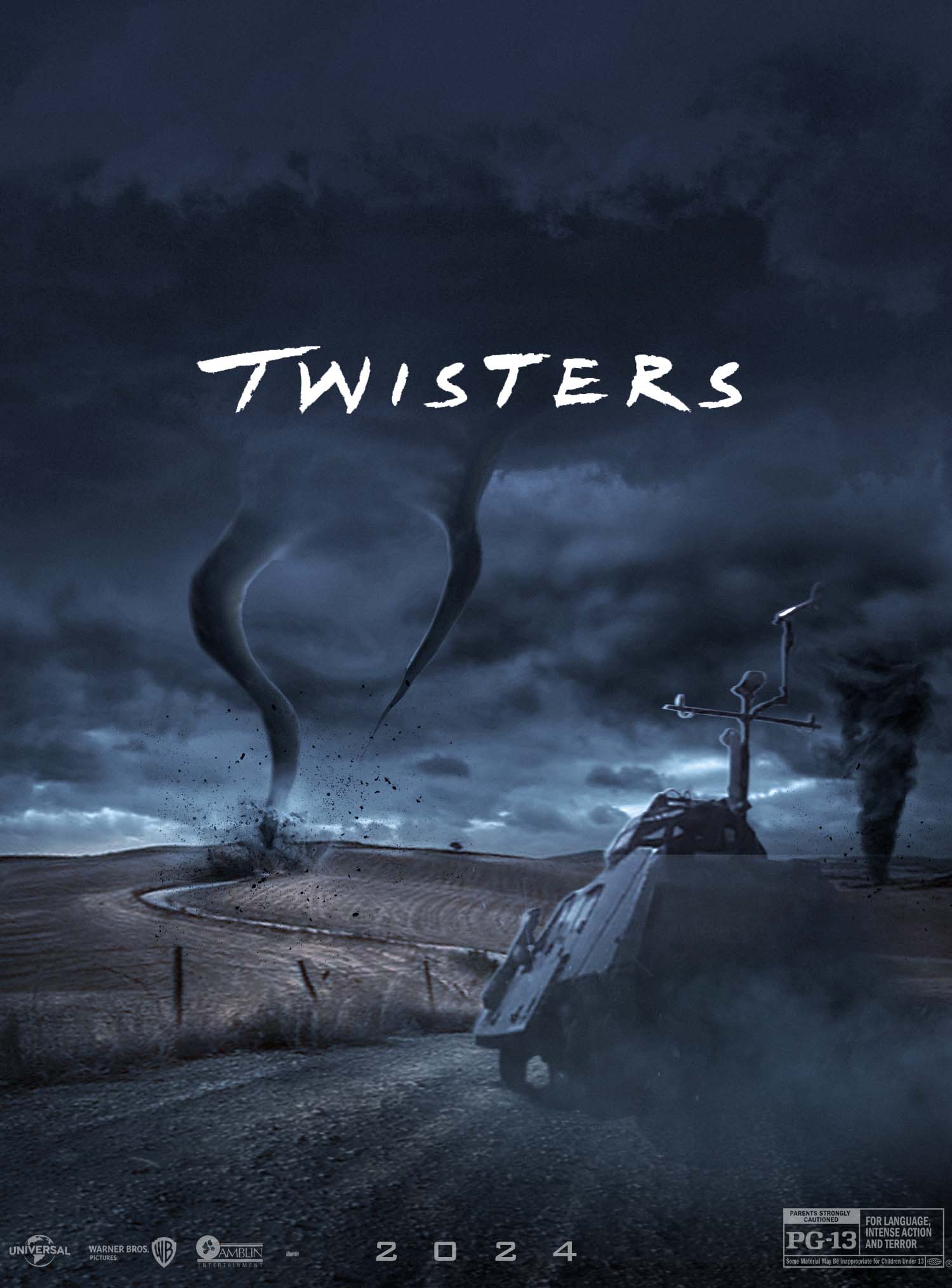Twisters 2024 is a topic that has captured the attention of millions worldwide, especially in areas prone to severe weather phenomena. As we step into a year where climate change continues to influence weather patterns, understanding twisters has never been more crucial. Whether you're a meteorologist, a curious individual, or someone living in tornado alley, this guide will provide everything you need to know about twisters in 2024.
Twisters, commonly known as tornadoes, are one of nature's most powerful and unpredictable forces. Their ability to devastate entire communities within minutes makes them a subject of both fascination and fear. As we dive deeper into this article, we'll explore the science behind twisters, how they form, and the latest trends in 2024.
This guide is designed to equip you with the knowledge you need to stay safe and informed. From understanding the meteorological conditions that lead to twisters to learning about the latest technologies used to predict them, this article will leave no stone unturned. Let's get started!
Read also:Discover The Comfort And Versatility Of Sleeper Sofas And Lounge Sofas
Table of Contents
- What Are Twisters?
- The Science Behind Twisters
- Tornado Alley: The Hotspot for Twisters
- Twisters 2024: Trends and Predictions
- Safety Preparations for Twisters
- Technology in Tornado Prediction
- A Historical Perspective on Twisters
- The Economic Impact of Twisters
- Community Response and Recovery
- Future Predictions for Twisters
What Are Twisters?
Twisters, or tornadoes, are violently rotating columns of air that extend from a thunderstorm to the ground. These phenomena are categorized by their destructive power, often reaching speeds of up to 300 miles per hour. In 2024, the occurrence of twisters is expected to follow similar patterns to previous years, with some regions experiencing more frequent and intense events due to climate change.
While twisters can occur anywhere in the world, they are most commonly associated with the United States, particularly in an area known as Tornado Alley. Understanding what twisters are and how they form is essential for anyone living in or visiting these regions.
Key Characteristics of Twisters
- Rotating winds with speeds exceeding 100 mph
- Capable of causing significant damage to infrastructure
- Short-lived but highly destructive
The Science Behind Twisters
Twisters form under specific meteorological conditions, typically involving the interaction of warm, moist air from the Gulf of Mexico with cooler, drier air from Canada. This clash creates an unstable atmosphere, leading to the development of supercell thunderstorms, which are responsible for the majority of tornadoes.
In 2024, advancements in meteorology have allowed scientists to better predict the formation of twisters. By studying factors such as wind shear, humidity levels, and atmospheric pressure, meteorologists can identify areas at high risk for tornado development.
Factors Contributing to Twister Formation
- Wind shear: A change in wind speed and direction with height
- Humidity: High levels of moisture in the air
- Atmospheric instability: Differences in temperature and pressure
Tornado Alley: The Hotspot for Twisters
Tornado Alley, a region spanning several states in the central United States, is infamous for its frequent twister activity. This area, which includes states like Texas, Oklahoma, Kansas, and Nebraska, experiences some of the most powerful tornadoes in the world. In 2024, experts predict that Tornado Alley will continue to be a hotspot for twister activity.
Living in Tornado Alley requires a heightened awareness of weather conditions and preparedness for emergencies. Residents of this region are encouraged to stay informed about weather updates and have emergency plans in place.
Read also:Steve Martin Daughter A Comprehensive Look At Her Life And Legacy
States Most Affected by Twisters
- Oklahoma
- Kansas
- Nebraska
- Texas
Twisters 2024: Trends and Predictions
In 2024, experts predict that twister activity will be influenced by ongoing climate change. Warmer ocean temperatures and increased atmospheric moisture may lead to more frequent and intense tornadoes in certain regions. Additionally, advancements in technology and data analysis have improved our ability to predict and respond to these events.
Data from the National Oceanic and Atmospheric Administration (NOAA) suggests that the frequency of tornadoes has remained relatively stable over the past few decades. However, the intensity and unpredictability of twisters have increased, posing new challenges for communities.
Key Predictions for 2024
- Increased tornado intensity in certain regions
- Improved prediction accuracy through advanced technology
- Greater emphasis on community preparedness
Safety Preparations for Twisters
Preparing for twisters is crucial for minimizing damage and ensuring the safety of individuals and communities. In 2024, it's important to have a well-thought-out emergency plan that includes communication strategies, evacuation routes, and designated safe spaces.
Investing in tornado shelters and reinforcing structures can significantly reduce the impact of twisters. Additionally, staying informed about weather alerts and having emergency supplies on hand can make a difference during a crisis.
Steps to Prepare for Twisters
- Create an emergency plan with your family
- Invest in a tornado shelter or safe room
- Stay informed about weather updates
Technology in Tornado Prediction
Advancements in technology have revolutionized the way we predict and respond to twisters. In 2024, tools such as Doppler radar, satellite imagery, and artificial intelligence are being used to enhance our understanding of tornado formation and behavior.
These technologies allow meteorologists to provide earlier warnings and more accurate forecasts, giving communities more time to prepare. Additionally, mobile apps and social media platforms are being utilized to disseminate critical information quickly and efficiently.
Technologies Used in Tornado Prediction
- Doppler radar
- Satellite imagery
- Artificial intelligence
A Historical Perspective on Twisters
Twisters have been a part of human history for centuries, with some of the most notable events occurring in the United States. The Tri-State Tornado of 1925, for example, remains one of the deadliest tornadoes on record, causing significant loss of life and property damage.
Studying historical twister events provides valuable insights into their behavior and impact. By analyzing past occurrences, scientists can better predict future trends and develop strategies to mitigate their effects.
Notable Twister Events
- Tri-State Tornado (1925)
- Joplin Tornado (2011)
- Moore Tornado (2013)
The Economic Impact of Twisters
The economic impact of twisters is significant, with billions of dollars in damages reported annually. In 2024, experts predict that the cost of twister-related damages will continue to rise due to increased urbanization and infrastructure development in high-risk areas.
Governments and insurance companies are working together to develop policies and programs that address the financial burden of twister events. These efforts aim to provide relief to affected communities and encourage investment in disaster-resistant infrastructure.
Economic Costs of Twisters
- Property damage
- Loss of income
- Reconstruction expenses
Community Response and Recovery
Community response and recovery are critical components of dealing with twister events. In 2024, there is a growing emphasis on building resilient communities that can withstand and recover from natural disasters.
Efforts such as community drills, public education campaigns, and collaboration with emergency services are essential for ensuring a coordinated response. Additionally, supporting mental health services for affected individuals is becoming a priority in post-disaster recovery.
Key Strategies for Community Response
- Conduct regular emergency drills
- Provide mental health support
- Collaborate with local authorities
Future Predictions for Twisters
Looking ahead, the future of twisters in 2024 and beyond is shaped by ongoing climate change and technological advancements. While the frequency of tornadoes may remain stable, their intensity and unpredictability are expected to increase.
Investing in research and development of new technologies, as well as promoting sustainable practices, will be crucial in mitigating the impact of twisters. By working together, communities can build a safer and more resilient future.
Future Trends in Twister Research
- Advancements in predictive modeling
- Development of disaster-resistant infrastructure
- Increased focus on climate change mitigation
Conclusion
Twisters 2024 represents a pivotal moment in our understanding and response to these powerful natural phenomena. By staying informed, preparing adequately, and leveraging the latest technologies, we can minimize their impact and protect our communities.
We encourage you to share this article with others and leave your thoughts in the comments below. For more information on twisters and other weather-related topics, explore our other articles and resources. Together, we can build a safer and more resilient world.


